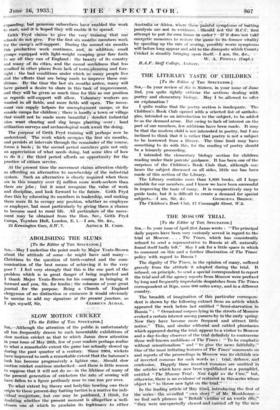SLOW MOTION CRICKET [To the Editor, of THE . Seucrlyroa.] Smn,—Although
the attention of the public is unfortunately all too frequently drawn to such lamentable exhibitions of slow motion cricket as that to which Janus drew attention in your issue of May 28th, few of your readers perhaps realize to what a remarkable extent the game has actually slowed up during the past quarter of a century. Since 1004, wickets have improved to such a remarkable extent that the batsman's task has become progressively a lighter one. Should slow motion 'cricket continue unchecked—and there is little reason to suppose that it will not do so—in the lifetime of many of the present generation of cricketers the rate of scoring will have fallen to a figure perilously near to one run per over.
To what extent leg theory and bodyline bowling owe their origin to these present-day batting tactics is a matter for indi- vidual' conjecture, but one may be pardoned, I think, for doubting whether the present moment is altogether a. well- chosen one at which to proclaim its legitimacy to either
Australia or Africa. where these painful sYmptians of batting paralysis- are not in-evidenee. Should' not the M.C.C. first attempt to put its' own- lastse an -order ? - • If 41 -does-'net tak energetic measures to restore the genie to itd- former vitality by speeding up the rate of scoring, possibly worse 'symptoms will before long appear and add to the disrepute 'which County Cricket is steadily bringing upon itself.—I am, Sir, &c., ■










































 Previous page
Previous page